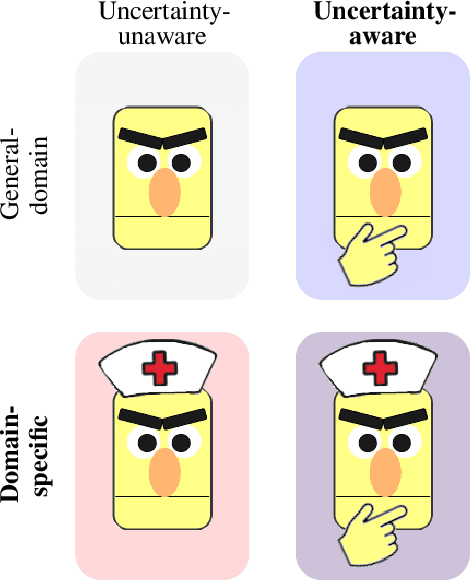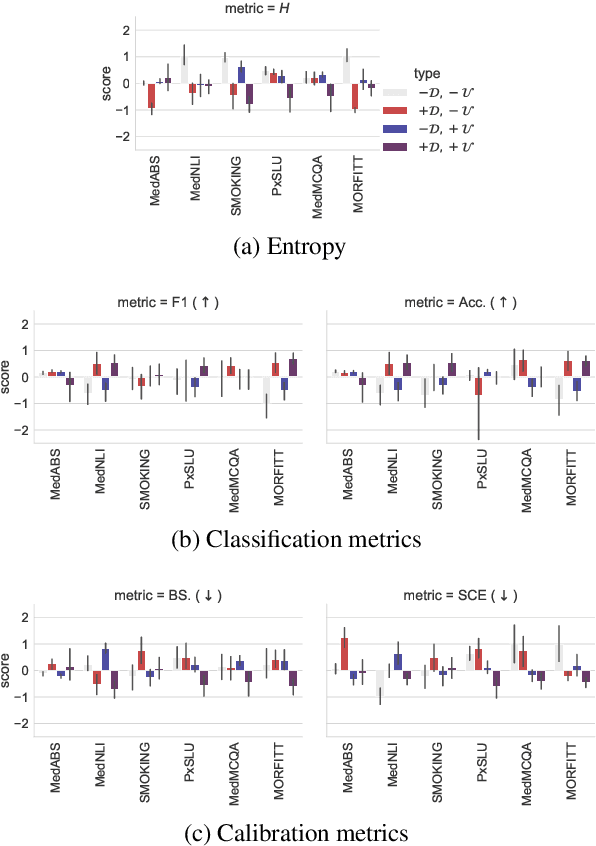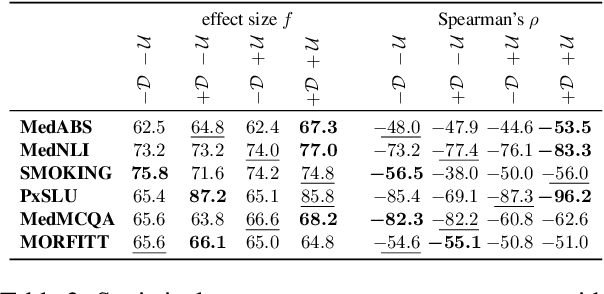Timothee Mickus
SemEval-2025 Task 3: Mu-SHROOM, the Multilingual Shared Task on Hallucinations and Related Observable Overgeneration Mistakes
Apr 16, 2025Abstract:We present the Mu-SHROOM shared task which is focused on detecting hallucinations and other overgeneration mistakes in the output of instruction-tuned large language models (LLMs). Mu-SHROOM addresses general-purpose LLMs in 14 languages, and frames the hallucination detection problem as a span-labeling task. We received 2,618 submissions from 43 participating teams employing diverse methodologies. The large number of submissions underscores the interest of the community in hallucination detection. We present the results of the participating systems and conduct an empirical analysis to identify key factors contributing to strong performance in this task. We also emphasize relevant current challenges, notably the varying degree of hallucinations across languages and the high annotator disagreement when labeling hallucination spans.
Your Model is Overconfident, and Other Lies We Tell Ourselves
Mar 03, 2025Abstract:The difficulty intrinsic to a given example, rooted in its inherent ambiguity, is a key yet often overlooked factor in evaluating neural NLP models. We investigate the interplay and divergence among various metrics for assessing intrinsic difficulty, including annotator dissensus, training dynamics, and model confidence. Through a comprehensive analysis using 29 models on three datasets, we reveal that while correlations exist among these metrics, their relationships are neither linear nor monotonic. By disentangling these dimensions of uncertainty, we aim to refine our understanding of data complexity and its implications for evaluating and improving NLP models.
Two Stacks Are Better Than One: A Comparison of Language Modeling and Translation as Multilingual Pretraining Objectives
Jul 22, 2024Abstract:Pretrained language models (PLMs) display impressive performances and have captured the attention of the NLP community. Establishing the best practices in pretraining has therefore become a major point of focus for much of NLP research -- especially since the insights developed for monolingual English models need not carry to more complex multilingual. One significant caveat of the current state of the art is that different works are rarely comparable: they often discuss different parameter counts, training data, and evaluation methodology. This paper proposes a comparison of multilingual pretraining objectives in a controlled methodological environment. We ensure that training data and model architectures are comparable, and discuss the downstream performances across 6 languages that we observe in probing and fine-tuning scenarios. We make two key observations: (1) the architecture dictates which pretraining objective is optimal; (2) multilingual translation is a very effective pre-training objective under the right conditions. We make our code, data, and model weights available at \texttt{\url{https://github.com/Helsinki-NLP/lm-vs-mt}}.
Domain-specific or Uncertainty-aware models: Does it really make a difference for biomedical text classification?
Jul 17, 2024



Abstract:The success of pretrained language models (PLMs) across a spate of use-cases has led to significant investment from the NLP community towards building domain-specific foundational models. On the other hand, in mission critical settings such as biomedical applications, other aspects also factor in-chief of which is a model's ability to produce reasonable estimates of its own uncertainty. In the present study, we discuss these two desiderata through the lens of how they shape the entropy of a model's output probability distribution. We find that domain specificity and uncertainty awareness can often be successfully combined, but the exact task at hand weighs in much more strongly.
AXOLOTL'24 Shared Task on Multilingual Explainable Semantic Change Modeling
Jul 04, 2024Abstract:This paper describes the organization and findings of AXOLOTL'24, the first multilingual explainable semantic change modeling shared task. We present new sense-annotated diachronic semantic change datasets for Finnish and Russian which were employed in the shared task, along with a surprise test-only German dataset borrowed from an existing source. The setup of AXOLOTL'24 is new to the semantic change modeling field, and involves subtasks of identifying unknown (novel) senses and providing dictionary-like definitions to these senses. The methods of the winning teams are described and compared, thus paving a path towards explainability in computational approaches to historical change of meaning.
I Have an Attention Bridge to Sell You: Generalization Capabilities of Modular Translation Architectures
Apr 30, 2024



Abstract:Modularity is a paradigm of machine translation with the potential of bringing forth models that are large at training time and small during inference. Within this field of study, modular approaches, and in particular attention bridges, have been argued to improve the generalization capabilities of models by fostering language-independent representations. In the present paper, we study whether modularity affects translation quality; as well as how well modular architectures generalize across different evaluation scenarios. For a given computational budget, we find non-modular architectures to be always comparable or preferable to all modular designs we study.
Can Machine Translation Bridge Multilingual Pretraining and Cross-lingual Transfer Learning?
Mar 25, 2024Abstract:Multilingual pretraining and fine-tuning have remarkably succeeded in various natural language processing tasks. Transferring representations from one language to another is especially crucial for cross-lingual learning. One can expect machine translation objectives to be well suited to fostering such capabilities, as they involve the explicit alignment of semantically equivalent sentences from different languages. This paper investigates the potential benefits of employing machine translation as a continued training objective to enhance language representation learning, bridging multilingual pretraining and cross-lingual applications. We study this question through two lenses: a quantitative evaluation of the performance of existing models and an analysis of their latent representations. Our results show that, contrary to expectations, machine translation as the continued training fails to enhance cross-lingual representation learning in multiple cross-lingual natural language understanding tasks. We conclude that explicit sentence-level alignment in the cross-lingual scenario is detrimental to cross-lingual transfer pretraining, which has important implications for future cross-lingual transfer studies. We furthermore provide evidence through similarity measures and investigation of parameters that this lack of positive influence is due to output separability -- which we argue is of use for machine translation but detrimental elsewhere.
SemEval-2024 Shared Task 6: SHROOM, a Shared-task on Hallucinations and Related Observable Overgeneration Mistakes
Mar 20, 2024Abstract:This paper presents the results of the SHROOM, a shared task focused on detecting hallucinations: outputs from natural language generation (NLG) systems that are fluent, yet inaccurate. Such cases of overgeneration put in jeopardy many NLG applications, where correctness is often mission-critical. The shared task was conducted with a newly constructed dataset of 4000 model outputs labeled by 5 annotators each, spanning 3 NLP tasks: machine translation, paraphrase generation and definition modeling. The shared task was tackled by a total of 58 different users grouped in 42 teams, out of which 27 elected to write a system description paper; collectively, they submitted over 300 prediction sets on both tracks of the shared task. We observe a number of key trends in how this approach was tackled -- many participants rely on a handful of model, and often rely either on synthetic data for fine-tuning or zero-shot prompting strategies. While a majority of the teams did outperform our proposed baseline system, the performances of top-scoring systems are still consistent with a random handling of the more challenging items.
MAMMOTH: Massively Multilingual Modular Open Translation @ Helsinki
Mar 12, 2024



Abstract:NLP in the age of monolithic large language models is approaching its limits in terms of size and information that can be handled. The trend goes to modularization, a necessary step into the direction of designing smaller sub-networks and components with specialized functionality. In this paper, we present the MAMMOTH toolkit: a framework designed for training massively multilingual modular machine translation systems at scale, initially derived from OpenNMT-py and then adapted to ensure efficient training across computation clusters. We showcase its efficiency across clusters of A100 and V100 NVIDIA GPUs, and discuss our design philosophy and plans for future information. The toolkit is publicly available online.
Isotropy, Clusters, and Classifiers
Feb 05, 2024Abstract:Whether embedding spaces use all their dimensions equally, i.e., whether they are isotropic, has been a recent subject of discussion. Evidence has been accrued both for and against enforcing isotropy in embedding spaces. In the present paper, we stress that isotropy imposes requirements on the embedding space that are not compatible with the presence of clusters -- which also negatively impacts linear classification objectives. We demonstrate this fact empirically and use it to shed light on previous results from the literature.
 Add to Chrome
Add to Chrome Add to Firefox
Add to Firefox Add to Edge
Add to Edge